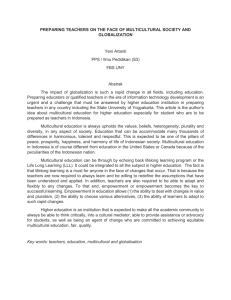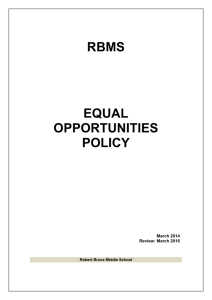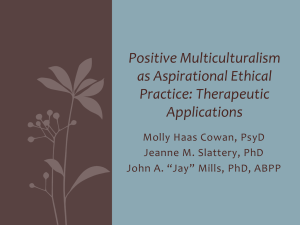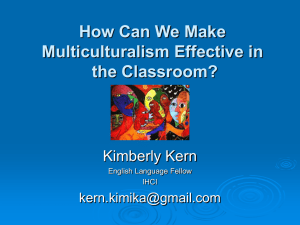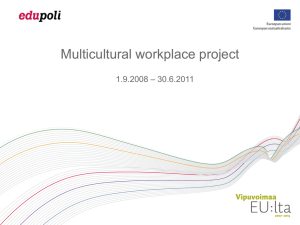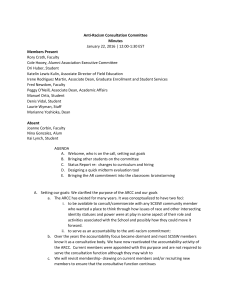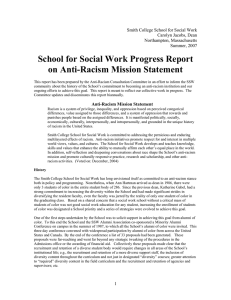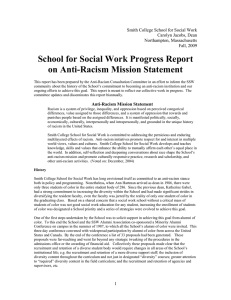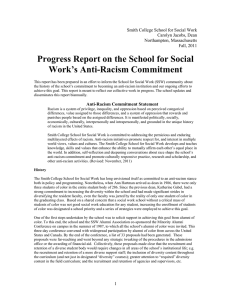Multicultural and anti-racism activities brainstorm
advertisement
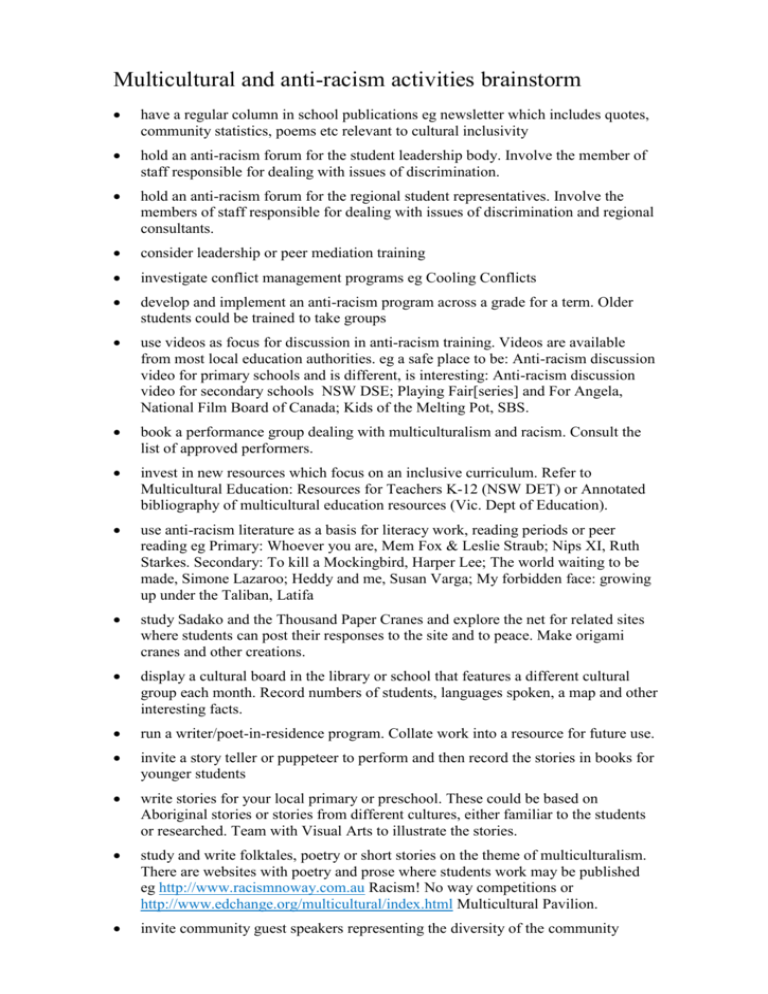
Multicultural and anti-racism activities brainstorm have a regular column in school publications eg newsletter which includes quotes, community statistics, poems etc relevant to cultural inclusivity hold an anti-racism forum for the student leadership body. Involve the member of staff responsible for dealing with issues of discrimination. hold an anti-racism forum for the regional student representatives. Involve the members of staff responsible for dealing with issues of discrimination and regional consultants. consider leadership or peer mediation training investigate conflict management programs eg Cooling Conflicts develop and implement an anti-racism program across a grade for a term. Older students could be trained to take groups use videos as focus for discussion in anti-racism training. Videos are available from most local education authorities. eg a safe place to be: Anti-racism discussion video for primary schools and is different, is interesting: Anti-racism discussion video for secondary schools NSW DSE; Playing Fair[series] and For Angela, National Film Board of Canada; Kids of the Melting Pot, SBS. book a performance group dealing with multiculturalism and racism. Consult the list of approved performers. invest in new resources which focus on an inclusive curriculum. Refer to Multicultural Education: Resources for Teachers K-12 (NSW DET) or Annotated bibliography of multicultural education resources (Vic. Dept of Education). use anti-racism literature as a basis for literacy work, reading periods or peer reading eg Primary: Whoever you are, Mem Fox & Leslie Straub; Nips XI, Ruth Starkes. Secondary: To kill a Mockingbird, Harper Lee; The world waiting to be made, Simone Lazaroo; Heddy and me, Susan Varga; My forbidden face: growing up under the Taliban, Latifa study Sadako and the Thousand Paper Cranes and explore the net for related sites where students can post their responses to the site and to peace. Make origami cranes and other creations. display a cultural board in the library or school that features a different cultural group each month. Record numbers of students, languages spoken, a map and other interesting facts. run a writer/poet-in-residence program. Collate work into a resource for future use. invite a story teller or puppeteer to perform and then record the stories in books for younger students write stories for your local primary or preschool. These could be based on Aboriginal stories or stories from different cultures, either familiar to the students or researched. Team with Visual Arts to illustrate the stories. study and write folktales, poetry or short stories on the theme of multiculturalism. There are websites with poetry and prose where students work may be published eg http://www.racismnoway.com.au Racism! No way competitions or http://www.edchange.org/multicultural/index.html Multicultural Pavilion. invite community guest speakers representing the diversity of the community study different periods of Australia’s migration history. Visit Making Multicultural Australia at http://www.multiculturalaustralia.edu.au. Assemble a timeline. study historical documents and speeches relating to multiculturalism or race relations (King, Mandela, Lincoln, Keating’s Redfern speech etc). Research on Making Multicultural Australia at http://www.multiculturalaustralia.edu.au. use a cultural diversity calendar eg Calendar for Cultural Diversity 2005 and Handbook, NSW DET Multicultural Programs Unit, to recognise and observe significant days. Roll classes may incorporate into daily routine. plan activities to observe days of major significance eg 21 March Harmony Day and International day for the Elimination of Racial Discrimination; 26 May National Sorry Day; 17 September Australian Citizenship Day; 21 September International Day of Peace; 24-30 National Refugee Week; 16 November International Day of Tolerance; 10 December International Human Rights Day create or add to your school’s website so that it better reflects the cultural diversity of the school contact an overseas school. Exchange letters and work samples. Raise money for aid or send resources if appropriate. as a school, sponsor a child through an organisation study videos of various travel programs or documentaries to highlight similarities and differences introduce some languages not usually offered at your school for a limited time and study both language and culture. Choose countries students may visit or come in contact with locally eg Indonesian, Fijian, Vietnamese, Thai study Australian identity. Use some of the lesson ideas from the Classroom activities section of the Racism. No way! site. These lessons may be used independently or to support other curriculum activities. eg I am, you are, we are...; Who participates?- Identifying diversity; Icons; You don't even look Aboriginal; Reflections; Investigating our multicultural world base graphing activities on school statistics relating to cultural diversity study mathematicians, scientists and theories that originate from different countries and civilisations. Include tessellations activities hold a visual arts exhibition focusing on anti-racism create cultural artefacts. Write reports. create decorative yet useful items such as puppets, kites, lanterns, masks or body art. Research their origins. organise a poster competition using anti-racism themes arrange an artist-in-residence focusing on Aboriginal or multicultural themes design and paint a cultural harmony mural for a playground wall create a mosaic reflecting the identity of the class, school or local community or based on a theme or significant event. Each student paints one large tile. All tiles are combined. study Australian cultural identity in Art study, make or play instruments from around the world study a type or range of music from around the world access M.U.S.I.C: Musicians United for Songs In the Classroom for a directory of popular songs and suggestions for how to teach and learn investigate racism and stereotyping in popular modern music invite community members to give cooking demonstrations run cultural diversity “Sale of the Century” team activities. Use questions from the Racism. No way! quizzes. have fun multicultural periods or wet weather activities! Introduce board games from around the world and rotate students. Play music! Dance! Sing! Read! Enjoy!

